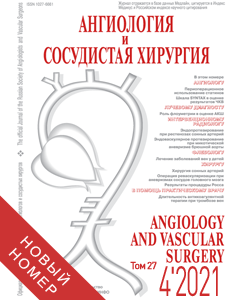Journal «Angiology and Vascular Surgery» •
2005 • VOLUME 11 • №2
COMBINED BOLUS MAGNETIC RESONANCE ANGIOGRAPHY AND TWO-DIMENSIONAL TIME-OF-FLIGHT MAGNETIC RESONANCE ANGIOGRAPHY IN PATIENTS WITH OCCLUSIVE DISEASES OF LOWER LIMB ARTERIES
M.Yu. Volodyukhin, M.M. Ibatullin, I.M. Mikhailov,M.N. Malinovsky, I.M. Ignatiev, R.A. Bredikhin
Department of Radiological Diagnosis and Treatment, Department of Radioolagnosis,
Department of Vascular Surgery, the State Institution Interregional Glinicodiagnostic Center,
Kazan, Russia
Objectives: the purpose of the work was to assess the diagnostic significance of combined bolus magnetic resonance angiography (MRA) and two-dimensional time-of-flight MRA of lower limb arteries as compared to radioangiography in patients with occlusive diseases of lower limb arteries.Materials and methods: twenty-six patients with the symptoms of lower limb ischemia of varying severity were provided bolus MRA with prolonged manual injection of contrast substance and transposition of the MR-tomograph table. Additionally, all the patients underwent two-dimensional time-of-flight (2D TOF) MRA of the leg arteries.Results: the statistic processing of bolus MSA for visualization of the pelvic segment has demonstrated its high sensitivity and specificity (97.74% and 92.31% respectively). On visualization of the femoral artery segment the sensitivity of this modality accounted for 97.57%, the specificity for 94.57%. In patients with severe ischemia, visualization of the leg arteries was difficult. Consequently, the specificity of the modality accounted for 44.58%. However, when this technique was combined with two-dimensional time-of-flight MRA of the leg arteries, the sensitivity and specificity of the modality reached 96.38% and 91.92% respectively.Conclusion: bolus MRA of lower limb arteries is marked by the high sensitivity and specificity for visualization of the arteries of the iliac and femoral segments. To visualize the leg arteries in patients with severe forms of lower limb ischemia, this modality should be supplemented by two-dimensional time-of-flight MRA.
KEY WORDS: magnetic resonance angiography, contrast angiography, lower limb ischemia.
P. 29
ARCHIVES MAGAZINE
2021 (Vol.27)
2020 (Vol.26)
2019 (Vol.25)
2018 (Vol.24)
2017 (Vol.23)
2016 (Vol.22)
2015 (Vol.21)
2014 (Vol.20)
2013 (Vol.19)
2012 (Vol.18)
2011 (Vol.17)
2010 (Vol.16)
2009 (Vol.15)
2008 (Vol.14)
2007 (Vol.13)
2006 (Vol.12)
2005 (Vol.11)
2004 (Vol.10)
2001 (Vol.7)
2000 (Vol.6)
1999 (Vol.5)
1998 (Vol.4)
1997 (Vol.3)


